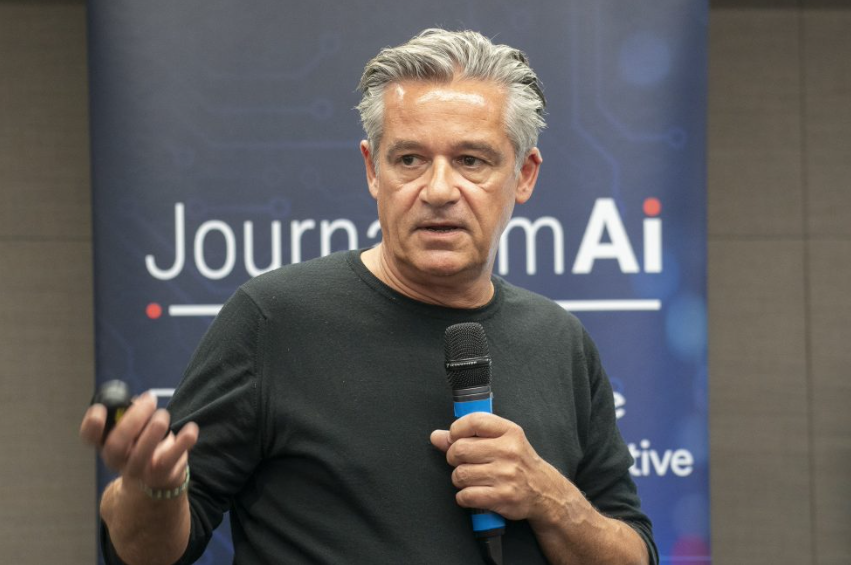
An Italian version of this article was published by the same author on 10 February 2025.
On 1 March 2013, Professor Charlie Beckett took the stage at the Madrid Press Association to tell the audience his idea of how to save journalism.
“The task is not to save the existing journalism industry, it’s about saving journalism – however it is made,” he wrote in his speech notes.
Beckett, founder and director of the London School of Economics journalism institute Polis, and a former senior programme editor at BBC and Channel 4 outlined his vision in Madrid, echoing arguments from his 2008 book “SuperMedia”.
By blending new technologies with traditional journalistic values, “we would make a better product,” he wrote. If audiences responded positively, “we would find a way to make money from it, too.”
But unlike old print-era monopolies that thrived on advertising alone, the digital news industry would require adaptive, multifaceted strategies.
Twelve years on, Beckett’s principles remain relevant, and technology continues to change journalism.
The latest game changer is artificial intelligence. Yet, its integration into newsrooms resembles a gradual – still challenging – transition, rather than an abrupt revolution.
On balance, today’s journalism is more varied and engaging than its analogue predecessor, which was often reliant on “cut and paste from press releases,” with much of the content closer to public relations, rather than original reporting.
Those “routine news” stories, he said, “are going to be written by AI. This frees up the other journalists.”
On the economic front, Beckett – who leads JournalismAI, an LSE project exploring the use of AI’s role in news organisations – dismissed a one-size-fits-all approach. Pursuing “only one solution is simplistic. So most news organisations are trying to diversify their revenue sources.”
AI is now part of the equation. More publishers are striking deals with AI companies to help stabilise their finances.

Professor Charlie Beckett, founder and director of LSE’s media think-tank Polis. Photo: courtesy of Charlie Beckett.
I’m not moving
Beyond economics, AI is also reshaping editorial decision-making, but a complete machine takeover is far from coming.
“Two of the most misleading claims that journalists have made about AI are the idea of the robot reporter and the belief that AI is going to write complicated stories,” Beckett said.
For now, chatbots are not replacing reporters.
Data seems to confirm this. According to a Press Gazette analysis, job cuts in the United Kingdom and the United States news industries halved in 2024 compared to the previous year, dropping from at least 8,000 to around 4,000. And they were not directly linked to AI.
A recent OECD study did not list media-related positions among the five occupations most exposed to AI’s impact. Even in sectors that are – such as C-level roles, science, engineering, and IT – empirical research has found little evidence of AI-driven job losses. Some studies even report positive effects.
“AI can sort things. What you can do is use all these tools to help you” in the news production process, Beckett said.
How automation assists newsrooms varies. Different levels of interaction take place between human editors and machines.
Some tasks are straightforward, such as training AI with effective prompts so it can draft routine news more accurately, saving newsrooms’ time and resources. The Washington Post‘s Heliograph is a case in point. This is particularly valuable for small and local outlets, where efficiency gains can be especially significant.
But the deeper challenges go beyond efficiency. They shape the entire news production process and affect how journalism is perceived.
Austrian news agency APA‘s deputy editor-in-chief, Katharina Schell, defines AI’s newsroom impact through two key concepts: agency and authorship.
“With AI, we are inviting a new ‘player’ into the room,” Schell wrote.
The extent to which this new colleague influences editorial decision-making remains unclear. In the digital media era, technology could “change” editorial decisions, but the current AI-driven shift “also makes them,” she argues.
In the near future, she suggests, editors may have to accept that their “authorial autonomy” is shared, recognising the “agency of non-human actors.”

CNN’s newsroom in 2008. Photo: Wikimedia Commons.
However, this does not mean human presence is fading in journalism’s evolving hybrid chapter.
“AI works best when you ask it to do particular things rather than everything all the time,” Beckett said. Creating “complicated stories” requires far more than text. It involves a journalist’s creativity, expertise, hierarchical data selection, analysis, and the ability to craft a compelling news angle.
In her research, Schell envisions chatbots playing an essential role in news-gathering, handling data mining and aggregation while sharing their analysis with human counterparts.
Challenging the perception that AI-generated content is inherently unreliable, machines will take on fact-checking duties. Independent fact-checkers are already instructing AI tools to accelerate and refine verification processes.
A significant shift will come in content creation. The drafting process will increasingly be handed to generative AI. Before that, journalists will still conduct brainstorming, structure ideas, and discipline chatbots. Afterward, they will edit and adapt outlines into a fully fleshed-out article.
Yet, inspiration remains a journalist’s prerogative.
“Beyond routine news, human judgment can more easily decide what’s really important, how to cover it, and why you should care,” Beckett said.
Most news consumption “is basically emotional,” he said. AI doesn’t replicate that. “AI doesn’t do emotions, doesn’t do judgment, doesn’t do curiosity. It has no sense of humour.”
Besides creativity, AI-generated long-form journalism also faces editorial constraints. Beckett sees a major challenge in maintaining stylistic consistency.
“I can ask ChatGPT to write something in the style of a specific personality, but it doesn’t understand what it means to be, for instance, right- or left-wing.”

MAGA supporters during a Trump rally. Photo: FMT.
Close to me
AI’s lack of human personality is a significant limitation for newspapers that rely on a strong editorial stance to engage their most ideologically aligned readers. Yet, chatbots can help identify countless new audience niches – perhaps too many.
In an era of deep political and social polarisation, an “AI-mediated information ecosystem” could exacerbate “increasing audience fragmentation,” driven by the hyper-personalisation of information, according to the findings of a recent report published by the Open Society Foundations.
This shift, the study warns, risks “the marginalisation of certain communities and increased social and political polarisation.”
Beckett, however, is sceptical. “I think there is a misunderstanding,” he said. “We are already in filter bubbles. That’s who we are. Don’t expect me to stop being me just because I’m reading some journalism.”
Polarisation, he argues, is a long-standing political phenomenon – particularly in the US. It was not caused by the media.
Yet, they are paying the price for polarisation. And the cost is high.
The latest Edelman Trust Barometer found that in 14 of 28 surveyed countries – including European countries, the US, and the UK – more than half of the population distrusts the media.
On the other hand, Beckett believes AI could help mainstream outlets understand what people want to read, listen to, or watch. He also downplays concerns over its negative impact.
“This won’t be the tyranny of the majority. If anything, it’ll be the tyranny of the minority,” he said.
Mainstream media today are “no longer the only major source of information.” They are “not that important,” he said, and “must accept that people will get their football news from their club or fan site. Niches can be left to others.”
And for those in the news industry concerned that AI-influenced audience insights will force media to surrender their agenda-setting power, Beckett offers a reality check: “This has always been the case. Nobody would write stories their readers didn’t like. That would be a suicide.”
Agenda-setting, he said, “has always been much more subtle than that. Often, it’s about what doesn’t get talked about.” It should be seen as an evolving “interchange” with the audience over time.

Photo: courtesy of Charlie Beckett.
So what
While editorial lines have traditionally prevented outlets from taking positions that might alienate their core audience, “until recently, news organisations were publishing a lot of stuff that didn’t interest their readers, while ignoring some of the things they actually cared about,” Beckett said.
The growing presence of AI will likely streamline the news selection process.
This could prompt elite mainstream media to expand their coverage beyond a rigid “pyramid where politics is at the top. But if you talk to people,” Beckett said, “it’s not.”
Another factor driving this shift is Google. As social media’s influence on news distribution wanes, the search engine has stepped in to fill the gap. Google Discover accounted for a quarter of total external traffic to news websites in 2024.
The Discover algorithm favours original and lighter content, pushing newsrooms to prioritise softer, less polarising topics.
However, this does not mean the fourth estate should relinquish its watchdog role. Beyond optimising the daily news schedule and offering more personalised feeds, AI represents journalism’s best opportunity to enhance quality reporting.
New tools allow editors to improve “the user experience,” Beckett said. “It’s not only about what you create, but how you create it.”

Donald Trump, the 45th and 47th president of the United States, has been featured twice as TIME’s Person of the Year, in 2016 and 2024. Photo: FMT.
A report from the Reuters Institute explored the industry’s key priorities and found that 56% of 326 media leaders surveyed remain confident in their business prospects, despite economic and political challenges. For 87%, generative AI will have some level of impact in their newsrooms.
Almost all respondents (96%) said implementing automation in back-end processes will be important, while 80% saw AI’s potential in personalising products and websites.
By 2025, AI-driven content creation is expected to focus on converting text into audio and generating short summaries and bullet points.
“Adding a short 30/40-word summary at the top of a 700-word article” helps the reader “know exactly what the piece is about,” Beckett said. “It doesn’t increase the click rate but improves engagement and read-through.”
This, he added, is a valuable metric since “normally, people look at the headline and decide ‘yes or no’ without really knowing whether they want to read it.” But when readers engage with a summary, grasp the content, and choose to continue, “they’re the ones who truly want it, they’ve made a choice. And it’s beautiful because you don’t want people reading stuff they’re not interested in.”
More than half of the Reuters Institute interviewees then planned to invest in multi-language translation tools and chatbots.
These trends were anticipated by TIME, which launched its chatbot alongside its second Person of the Year cover featuring Donald Trump. Developed in partnership with Scale AI, the tool summarises, reads aloud, translates, and answers questions about selected articles.
Besides AI-powered transformations, another key move is the strengthening of ties between newsrooms and news influencers, particularly after their growing impact during the recent US election campaign.
A growing number of outlets are collaborating with so-called “journo-influencers,” as defined in an LSE paper.
News organisations can “gain credibility through shared values that are communicated through influencers’ content.” Some of these figures have long worked in journalism and built their career through social media, such as Fox News foreign correspondent Trey Yingst.
“It’s not entirely new,” Beckett said. Personalities who have created a personal brand, like Tucker Carlson, “have always existed, especially in television, but also among newspaper columnists and reporters.”
News publishers are planning to use AI to lean further into format personalisation
Many will be exploring features that turn text into audio (75%), provide AI summaries (70%), or translate news articles (65%). Over half said they’d be looking into chatbots and search interfaces pic.twitter.com/xxmDHw08nT
— Reuters Institute (@risj_oxford) January 9, 2025
Everything counts
Collaborating with journo-influencers to reach new audiences and leveraging AI tools to make news production more affordable are just two recent examples of the myriad of strategies publishers have harnessed over the last 15 years to create a profitable business model.
A perfect formula doesn’t exist. It probably never did.
“In the past, a lot of journalism was funded by a complete coincidence. It was called advertising,” Beckett said. Without an organised plan, the only reason for placing advertising in newspapers, “rather than on a bus or TV,” was the logic of the “attention economy.”
It wasn’t a proper strategy, but it worked.
During the Madrid conference, to explain how the online revenues would not be enough on their own to sustain newsrooms, Beckett projected three freehand-drawn graphs.
They represented Beckett’s reinterpretation of the “Rusbridger cross”, a concept that stemmed from an assumption made by former Guardian editor Alan Rusbridger.
The Rusbridger cross represents the theoretical point where digital earnings overtake declining print revenue. When that happens, it means online revenues have supplanted print advertising.
But what Rusbridger really meant was that “there would be no neat transition from the old world to the new”, as he wrote. The ideal point is, in reality, an indefinite and puzzling period during which outlets suffer from declining income, even as digital readers outnumber print buyers.
In one of his sketches, Beckett illustrated this situation.

A graphic representation of the Rusbridger Cross used by Charlie Beckett in a conference at Madrid Press Association in 2013. Photo: LSE blogs.
“Even when you reach the Rusbridger Cross, you do so at a much lower level of overall revenues and profits than in those happy analogue days,” Beckett wrote.
To offset the slowness of digital revenues media began pursuing alternative income sources.
Over the years, publishers have developed premium services for companies and institutions, B2B divisions, academies, branded content, and gaming sections.
AI companies are the latest.
2024 marked the highest number of deals between media companies and AI firms. At least 26 international publishers struck agreements last year, Reuters Institute reported.
So far, according to Tow Center at Columbia University, OpenAI has confirmed 36 contracts, followed – with 21 – by Perplexity, which in September 2024 appointed former Meta and LinkedIn executive Jessica Chan as its new head of publisher relationships.
For the news industry, these contracts are an increasingly important way to replenish revenues, given the growing number of people using chatbots to stay informed and the improved capacity of AI models to search for and retrieve hard news.
Closing deals with AI companies, Beckett said, is “a practical thing to do. But it’s not something you can be dependent on.”
In fact, while some companies, like Google, usually “have some interest in a healthy information environment,” others do not. If “their values do not align,” it would be too risky to count on such volatile relationships.
“It’s a first step. Most news organisations are trying to diversify their revenue sources,” Beckett said. Nothing new, then.
Publishers are reacting differently.
An increasing number of publishers – including the Financial Times, News Corp, Condé Nast, Time, Der Spiegel, and the Italian editorial group GEDI – have signed licensing deals allowing AI systems to be trained on their news content.
OpenAI also launched partnerships with some media institutes to sustain local outlets and will directly fund four new Axios Local newsrooms in the US.
Before, in 2023, the New York Times sued OpenAI for copyright infringement and was joined by eight local US newspapers in 2024.
Recently, the New York Times lawyer, Ian Crosby, argued that ChatGPT and Bing could become substitutes for the newspaper’s website, effectively replacing newsrooms’ original work.
In another striking case, Los Angeles Times billionaire owner Patrick Soon-Shiong announced in December that the newspaper would introduce an AI-powered “bias meter” to inform readers about an article’s ideological inclination. It would also provide a button to generate an AI-written version and verify what the editor wrote.
Ties between AI companies and publishers are a double-edged sword, and the way the two sides are forging their relationship will shape the near future of the media industry.
Despite the uncertainties, “I’m surprised by how optimistic media leaders are” about AI, Beckett said. “I think it’s because they believe there will be efficiencies in it.”








